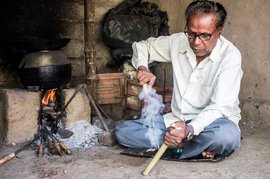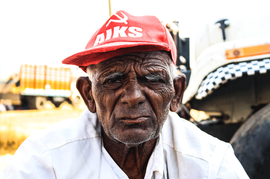Walking a livelihood tightrope – literally
PARI volunteer Sanket Jain aims to traverse 300 villages across India and, among other stories, produce this feature: a photograph of a rural scene or event and a sketch of that photograph. This is the third in the series on PARI. Draw the slider either way to see the photo or sketch in full
“I don’t know how to smile,” says 11-year-old Laxmi Prasad, a street artist from Bargaon village in Chhattisgarh. Laxmi, whose silhouette you see in the sketch and photograph, belongs to the Nat community, a Dalit group known for their skilled trapeze artists. These entertainers walk on a rope tied between two poles carrying a large balancing wooden staff in their hands. The rope, typically 25 to 30 feet in length, is at least 8 to10 feet above the ground. Artists as young as eight years of age perform across villages and towns in different states, migrating large distances to make ends meet. Laxmi’s family left their village in Pamgarh block of Chhattisgarh’s Janjgir-Champa district to perform well over 1,000 kilometres away, across Kolhapur and Sangli districts of Maharashtra. This photograph of her was taken on the outskirts of Ichalkaranji in Kolhapur.
She doesn’t have much to smile about. Her art form, which once entertained people across villages and towns, is in decline. The reason: competition from other types of entertainment, and a younger generation wanting to explore different livelihoods.
Laxmi must perform her risky routine at least six times a day, each set ranging from 45 to 60 minutes. The modest income, which depends on the mercy of the spectators, makes her sad. “Even after risking my life,” she says, “I have to beg for money. People give us between one and 10 rupees – which comes to less than Rs. 400 daily.”
Her father, Bhagvat Prasad, 36, reckons that less than 20 artists still practice these trapeze skills in Bargaon, a village of around 2,300 people. “Earlier, there was at least one Nat artist in each household. Today, nobody pays for this art in the village and so we migrate over a 1,000 kilometres to Maharashtra every year.”



